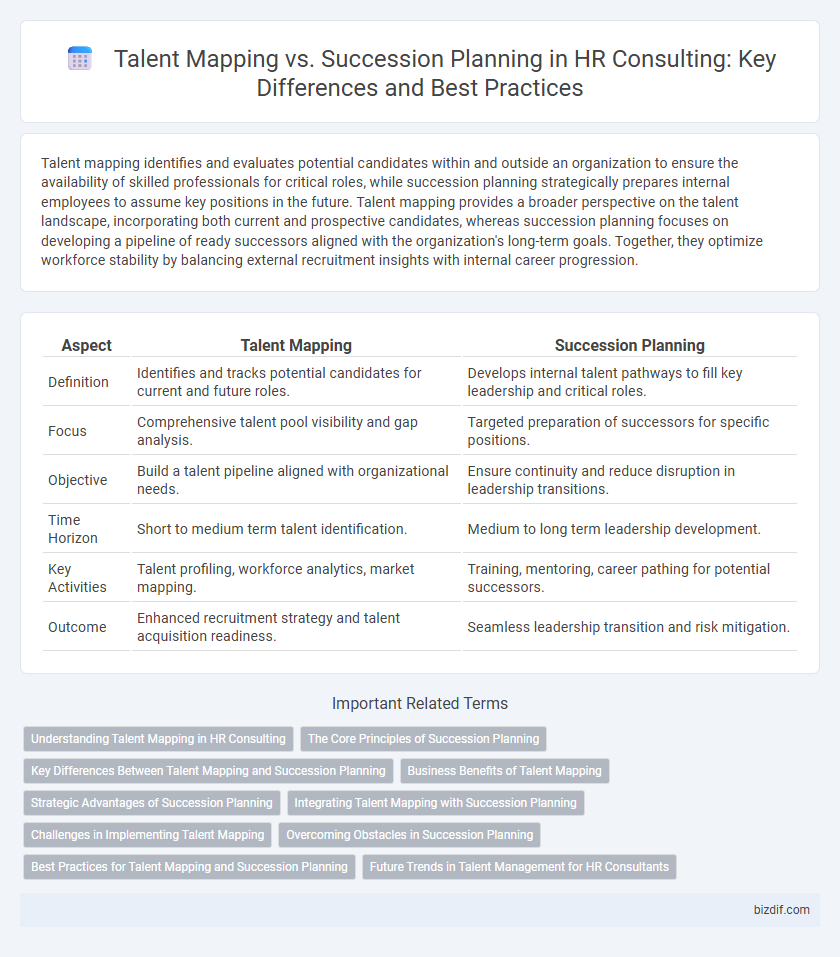Talent mapping identifies and evaluates potential candidates within and outside an organization to ensure the availability of skilled professionals for critical roles, while succession planning strategically prepares internal employees to assume key positions in the future. Talent mapping provides a broader perspective on the talent landscape, incorporating both current and prospective candidates, whereas succession planning focuses on developing a pipeline of ready successors aligned with the organization's long-term goals. Together, they optimize workforce stability by balancing external recruitment insights with internal career progression.
Table of Comparison
| Aspect | Talent Mapping | Succession Planning |
|---|---|---|
| Definition | Identifies and tracks potential candidates for current and future roles. | Develops internal talent pathways to fill key leadership and critical roles. |
| Focus | Comprehensive talent pool visibility and gap analysis. | Targeted preparation of successors for specific positions. |
| Objective | Build a talent pipeline aligned with organizational needs. | Ensure continuity and reduce disruption in leadership transitions. |
| Time Horizon | Short to medium term talent identification. | Medium to long term leadership development. |
| Key Activities | Talent profiling, workforce analytics, market mapping. | Training, mentoring, career pathing for potential successors. |
| Outcome | Enhanced recruitment strategy and talent acquisition readiness. | Seamless leadership transition and risk mitigation. |
Understanding Talent Mapping in HR Consulting
Talent mapping in HR consulting involves systematically identifying and evaluating the skills, experience, and potential of current employees to align with future organizational needs. This process provides a strategic overview of talent pools, enabling HR professionals to forecast skill gaps and design targeted development programs. Unlike succession planning, which focuses primarily on preparing specific individuals for key roles, talent mapping offers a broader, data-driven approach to workforce planning and talent acquisition.
The Core Principles of Succession Planning
Succession planning centers on identifying and developing internal talent to ensure seamless leadership transitions, emphasizing long-term organizational stability. Core principles include aligning talent development with business strategy, nurturing high-potential employees through targeted training, and creating clear career pathways to retain critical roles. Unlike talent mapping, which provides a snapshot of current capabilities, succession planning systematically prepares future leaders to meet evolving company needs.
Key Differences Between Talent Mapping and Succession Planning
Talent mapping involves identifying and evaluating potential candidates in the external and internal talent pool to forecast future hiring needs, while succession planning focuses on developing internal employees to fill critical leadership roles when vacancies arise. Talent mapping provides a broad overview of market talent trends and competitor benchmarking, whereas succession planning ensures a ready pipeline of qualified individuals for specific positions within the organization. The key difference lies in talent mapping's focus on talent acquisition strategy and external benchmarking compared to succession planning's emphasis on internal workforce development and leadership continuity.
Business Benefits of Talent Mapping
Talent mapping enables organizations to identify high-potential employees and skill gaps, facilitating targeted development and strategic workforce planning. By providing a clear view of current and future talent pools, businesses can reduce recruitment time and costs while enhancing leadership pipelines. Implementing effective talent mapping drives better decision-making and supports sustained organizational growth through proactive talent management.
Strategic Advantages of Succession Planning
Succession planning offers strategic advantages by ensuring leadership continuity and minimizing disruptions during key transitions. It provides a proactive approach to identify and develop internal talent, aligning workforce capabilities with long-term organizational goals. This readiness reduces recruitment costs and accelerates onboarding, strengthening overall business resilience.
Integrating Talent Mapping with Succession Planning
Integrating talent mapping with succession planning enhances organizational readiness by providing a comprehensive view of current and future talent capabilities, ensuring critical roles are consistently filled with qualified candidates. Talent mapping identifies high-potential employees and skill gaps, while succession planning aligns this data with strategic leadership development and career pathing. This combined approach improves workforce agility, reduces hiring risks, and supports long-term business continuity.
Challenges in Implementing Talent Mapping
Implementing talent mapping faces challenges such as data accuracy issues, where outdated or incomplete employee information hinders precise skill and potential assessments. Organizations often struggle with aligning talent mapping efforts to long-term business goals, leading to ineffective identification of future leaders. Resistance to change and limited stakeholder buy-in further complicate the integration of talent mapping into existing HR processes.
Overcoming Obstacles in Succession Planning
Effective succession planning faces obstacles such as identifying high-potential employees and aligning their growth with organizational goals, challenges addressed by comprehensive talent mapping. Talent mapping provides a clear visual of internal capabilities and future skill requirements, enabling HR consultants to proactively develop leadership pipelines. Overcoming succession planning hurdles depends on integrating talent analytics and continuous workforce assessment to ensure readiness for critical roles.
Best Practices for Talent Mapping and Succession Planning
Best practices for talent mapping emphasize continuous data collection and analysis to identify high-potential employees aligned with future organizational needs. Succession planning benefits from clearly defined leadership competencies and regular reviews to ensure readiness and minimize talent gaps. Integrating talent mapping insights with succession strategies enhances workforce agility and leadership continuity.
Future Trends in Talent Management for HR Consultants
Talent mapping leverages advanced analytics and AI to identify potential candidates aligned with future organizational needs, while succession planning focuses on developing internal talent pipelines for key leadership roles. Emerging trends indicate a shift towards integrated platforms that combine talent mapping with continuous skill assessments and personalized development plans to enhance workforce agility. HR consultants must adapt by utilizing these technologies to predict skill gaps, optimize talent pools, and create dynamic succession strategies that support long-term business resilience.
Talent mapping vs succession planning Infographic

 bizdif.com
bizdif.com